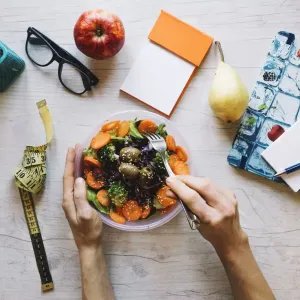

Our Review Process
Our articles undergo extensive medical review by board-certified practitioners to confirm that all factual inferences with respect to medical conditions, symptoms, treatments, and protocols are legitimate, canonical, and adhere to current guidelines and the latest discoveries. Read more.
Our Editorial Team
Shifa Fatima, MSc.
Author
Dr. Apoorva T, MHM.
MEDICAL ADVISOR
What Fruits Diabetics Should Avoid?
Consumption of fruits and vegetables can highly reduce the risk of heart disease and cancer, but not diabetes. Fruit is a good source of vitamins, minerals, and fiber. Fruit, on the other hand, can be heavy in sugar. To minimize blood sugar spikes, a person with diabetes must closely check their sugar consumption. However, there is a distinction between the sugar found in fruit and the sugar found in other meals like chocolate and baked goods. Let's look at which fruits to avoid in diabetes. Fruits must be present as part of a well-balanced diet. Fiber, vitamins, and minerals are all present in fruits. However, because certain fruits are high in sugar, people with diabetes should avoid them to avoid a glucose rise in their bodies. Diabetes is a chronic condition spread around the globe, affecting both adults and children. Diabetes that is not well controlled can lead to heart disease, renal disease, blindness, and other issues. These disorders also have connections to prediabetes. Significantly, certain meals can significantly elevate blood sugar and insulin levels and induce inflammation, thereby increasing your disease risk. Also know which fruits are good for diabetes
Table of Contents
Worts diabetes Fruits: Nutritional profile
It is vital to know about the list of fruits to avoid diabetes. Fruits that have a high glycemic index and contain natural sweeteners must be avoided as these spike blood sugar levels. Listed below are the top 5 worst fruits for diabetes.
| Specification | Fruit 1 | Fruit 2 | Fruit 3 | Fruit 4 | Fruit 5 |
|---|---|---|---|---|---|
| Rating | Watermelon | Pineapple | Banana | Mango | Lychee |
| GI | 76 | 62 | 59 | 51 | 50 |
| Advantage | Beta carotene, potassium | Potassium | Vitamin C | Vitamin A, Vitamin C | Vitamin C |
Now that you know which fruits to avoid in diabetes, you must also know that this doesn’t imply that you should eliminate them from your diet. Mix these fruits with other low-GI fruits to balance your blood sugar levels. This is essential because the advantages these fruits provide cannot be neglected.
Read more about sugar in watermelon
List of fruits diabetics should avoid
Excluding fruits from your diet is not advisable for diabetics as fruits are rich in fiber which is good for your health. However, it is recommended that fruits that fall under the following categories should be eaten moderately.
Fruits with high sugar content
The glycemic index of fruits directly impacts blood sugar levels. Fruits with high GI should not be consumed excessively. High GI fruit range between 70-100. Fruits that fall under this category are watermelons and overly ripe bananas. Being a diabetic you should consume more quantities of fruits with low GI than an excessive quantity of high GI fruits. Know about diabetes treatment.
Fruits with high carbohydrates
Consumption of carbohydrates should be optimum as it affects your blood sugar levels. If you are consuming a low-carb diet then you must cut out unhealthy carbs that contain fewer nutrients. Consume fresh fruits whose carb content is comparatively less. Certain fruits that are high in carbohydrates include
Fruit Juice
Although fruit juices are packed with vitamins and nutrients, they are not ideal for a diabetic diet as fruit juices lack fibers that help to smooth the digestion process and balance the blood sugar levels as fibers slow down the absorption of sugar into the blood. Instead of fruit juices consume whole fruits so that your body gets enough fiber to function smoothly. Know about is honey good for diabetes?.
Dried fruits
Dried fruits are good until they are not dried with added sugars which makes them unsuitable for diabetes. Also, avoid nuts covered with salt (sodium) as it spikes blood sugar levels. Certain dried fruits that diabetics must avoid include
1. Pineapple
When you chew into a juicy pineapple, you can tell it's loaded with sugar. The wonderful, sticky goo flowing down your chin contains about 16 grams of sugar per cup. You may reduce the serving size by topping a yogurt parfait with chopped pineapple. After that, have a look at our 7-day diabetic food plan. Keep this fruit in mind if you wonder which fruits to avoid in diabetes.
2. Dried Cranberries & Raisins
The sugar content of real cranberries is modest, with only 4 grams per cup. However, once they've been dried and sweetened, they're no longer a healthy option for a person who has diabetes. Use a tiny handful of dried cranberries topping for oatmeal or a salad like this one instead of eating them on their own. When looking for which fruits to avoid in diabetes, cranberries need to be your first option.
While these are a convenient on-the-go snack, they aren't the ideal choice if you're trying to keep your blood sugar in check. According to the experts, people with diabetes should restrict their fruit servings to 15 grams of carbs. There are around 115 grams of sugar in a cup of raisins! Substitute grapes or a tiny amount with a handful of almonds to balance the sweetness. These are the essential fruits to avoid diabetes. Also read about are grapes good for diabetes
3. Figs
Figs are sweet, which is why they make a great cookie filling. A cup of figs has roughly 29 grams of sugar in it. Skip the store-bought cookies and make your diabetic-friendly treats at home for less sugar and more flavor. When persons with diabetes eat too many carbohydrates at once, their blood sugar levels can spike dangerously. High amounts can harm your body's neurons and blood vessels over time, leading to heart disease, renal illness, and other significant health problems. Low carbohydrate consumption can help avoid blood sugar increases and lower the risk of diabetes complications.
4. Mangos
Can diabetics eat mango? While a slice of mango may quickly transport you to your last tropical getaway, saving this fruit for special occasions is better. Mango has 23 grams of sugar per cup; therefore, opt for fruits with less sugar. It is one of the primary fruits diabetics should avoid.
5. Cherries
A cup of this delicious fruit may seem like the perfect summer snack, but it might spike your blood sugar. One cup includes 20 grams of sugar and will almost certainly leave you hungry. With this honey lime berry salad, you may switch up your usual summer fruit. Fruit is an essential component of every person's diet. Fresh fruit does not contain free sugars, which might alter a person's blood sugar, despite fruits containing a lot of sugar. Fruits also include a lot of fiber, which helps to slow down sugar absorption into circulation.
6. Lychees
These are the next fruit that you must avoid. Lychees are very juicy and have a massive presence of sugar in them. If you have diabetes, then you must avoid this fruit. The macronutrients that supply energy to your body include carbohydrates, protein, and fat. Carbs, by far, have the most significant impact on your blood sugar. They are broken down into sugar (glucose) and absorbed into the circulation. Starches, sugar, and fiber are all examples of carbohydrates. On the other hand, your body will not absorb and digest fiber like other carbohydrates, so it doesn't boost your blood sugar.
Also, read more about is papaya good for diabetes and is banana good for diabetes
7. Raisins
Raisins have around 115 grams of sugar per cup which is terrible for people with diabetes. Instead, go for grapes or a little quantity of raisins with almonds to balance the sweetness.
Also read about the amount of sugar in watermelon
Avoid fruit snacks or frozen fruits
If you are a diabetic local and seasonal fruits are best for you. Do not consume frozen fruits as these contain added sugar and have fewer nutrients. Added to that, fruit snacks containing gummies or fruits like cherries and lychees are also high in sugar content making them bad options for diabetics.

Tips to enjoy fruits if you are diabetic
Living as a diabetic can feel overwhelming at times due as you always have to be logical with your eating habits. However, if you know how to consume fruits in the right manner then there is no need to cut a particular fruit completely from your diet. Here are some tips that you should follow to relish fruits without any guilt.
- Consume fresh, local, and seasonal fruits.
- Never intake fruits with your meals, always consume them between meals or munch on them as snacks.
- If you are consuming smoothies or shakes, make sure to blend the fruits with low-fat milk or curd.
- To balance the glycemic index of high GI fruits eat them along with seeds and nuts.
- Add little cinnamon to your fruits as it’s the best ingredient to balance blood sugar levels.
- Ensure that you consume fruits in regulated amounts and add them to your desserts for sweetening.
Fruits to include in your diet
Consuming a nutritious diet is the key to managing diabetes effectively. You must incorporate fruits into your diet so that your body can fulfill its requirement of essential vitamins and minerals that are present in fruits. Being a diabetic you should go for fruits with low glycemic index as these keep the sugar levels under control. Here’s a list of fruits that a diabetic can relish.
- Apricots
- Apples
- Avocados
- Blackberries
- Blueberries
- Banana
- Cherries
- Cantaloupes
- Grapefruits
- Grapes
- Kiwis
- Honeydew melons
- Nectarines
- Oranges
- Papayas
- Peaches
- Pears
- Pineapples
- Plums
- Tangerines
- Raspberries
- Strawberries
Also know about prediabetes diet.
Portion Sizes
Apart from knowing what fruits to avoid in diabetes, consuming the right fruits in the correct quantity is equally important as this will help you to manage your calorie intake efficiently. An ideal diet would have at least 5 servings of fruits and vegetables daily. The following tables highlight the number of fruits required to constitute a portion.
| Portion | Example |
|---|---|
| Small fresh fruit- 2 or more | 2 kiwi fruits |
| - | 2 satsumas |
| - | 2 plums |
| - | 3 apricots |
| - | 6 lychees |
| - | 7 strawberries |
| - | 14 cherries |
| Medium-sized fruits- 1 fruit | 1 orange |
| - | 1 pear |
| - | 1 apple |
| - | 1 banana |
| - | 1 nectarine |
| Large-sized fruit- less than 1 fruit | A single slice of papaya (ideally a 5cm slice) |
| - | Half grapefruit |
| - | Slice of mango (ideally 2-5 cm) |
| 30 g dried fruits | 1 tablespoon of raisins or currants |
| - | Dried figs- 2 |
| - | Banana chips- a handful |
| Canned fruit in natural juice | 8 segments of grapefruit |
| - | 2 pear or peach halves |
Bottomline
When it comes to diabetes, fruits have a terrible image. You must know which fruits to avoid in diabetes. Because of their high sugar content, many people believe that a person with high blood sugar must avoid fruits. Is that true, though? Check out the list above of the worst fruits for diabetes to avoid. Look at the levels in which you can use them in your diet, or you can also improve your health with their alternative options. True, fruits contain sugar. However, one can use some fruits in a high blood sugar diet. Some fruits include natural sugar as well as nutrients and fiber. Those who have diabetes and still want to enjoy sweet condiments will find it a healthier choice. Read is guava good for diabetes.
FAQs
What are the fruits with less sugar?
There are loads of fruits that have less sugar content and these are good to control blood sugar levels. Such fruits include lemons that are rich in vitamin C, and berries like raspberries, strawberries, and blackberries. Added to that, fruits like kiwi, avocado, oranges, and peaches are also low in sugar content. Although these fruits may contain low sugar the serving count makes all the difference so, make sure to consume them in a controlled manner.
Fruits to avoid for prediabetes?
If a prediabetic person does not avoid consuming sugars then such a person is at a higher risk of getting diagnosed with diabetes. Having rising blood sugar, these people must avoid fruits that have high sugar and carb content. These fruits include figs, grapes, mangoes, cherries, and overly ripe bananas. Apart from these the fruits that have low sugar content must also be consumed in small quantities as eating greater proportions of these would fluctuate your sugar levels.
What fruit should diabetics avoid?
Though most fruits are good for diabetes, being a diabetic you should avoid fruits that have a high glycemic index. Fruits like tangerines, cherries and grapes have a Low to moderate GI. However, rather than eliminating them, you can have them in negligible quantities to satisfy your cravings.
Which fruits raise blood sugar?
Apart from the fruits that are good for diabetic people, there are some fruits that a diabetic should avoid as they can raise blood sugar levels. These fruits are cherries, ripped bananas, mangoes, figs, lychees, pineapple, grapes, tangerines, raisins, sweetened cranberries, etc. If you eat these in huge quantities then the sugar content in them raises your blood sugar levels and worsens your health.
What is the best fruit to eat with diabetes?
Fruits like papaya, oranges, apples, peaches, blackberries, raspberries, plum, dragon fruit, avocados, apricots, pears, etc. are the best fruit options for diabetic people. Apart from keeping the sugar levels maintained these fruits provide essential vitamins and nutrients. Added to that you must consume whole fruit rather than fruit juice as whole fruits are fibrous and fruit juice can affect sugar levels negatively.
Which fruits to avoid in diabetes?
Being a diabetic you must avoid fruits that are high in the glycemic index such as overly ripe bananas, watermelons, etc. Apart from these, fruits with high carbohydrates such as pineapples, figs, and mangoes are also not suitable. Also, avoid fruit juice and consume whole fruits for balanced sugar levels.
References
- https://www.medicalnewstoday.com/articles/worst-fruits-for-diabetics
Disclaimer
This website's content is provided only for educational reasons and is not meant to be a replacement for professional medical advice. Due to individual differences, the reader should contact their physician to decide whether the material is applicable to their case.








